Design and manufacturing of wastewater evaporators
At Condorchem Enviro Solutions we design and install vacuum evaporators for industrial wastewater treatment. Industrial water evaporators have proven to be one of the most efficient solutions for the management and reuse of wastewater. Furthermore, they are highly effective in recovering raw materials and by-products from a wastewater stream in all types of industrial activities.
Condorchem's vacuum evaporators deliver constant innovations and solid engineering. We customize every industrial evaporator to provide more efficiency and durability to our customers than any other wastewater equipment manufacturer.
Industrial vacuum evaporators are the best technology for implementing a zero liquid discharge system, where wastewater is transformed into two streams, one containing solid waste with reusable resources (mainly raw materials and by-products) and another one with high quality water, which can be reused. We can deliver a zero liquid discharge system that will allow your company to achieve the following goals:
- Reuse 98% of the water
- Recover valuable raw materials and by-products dissolved in the water
- Minimize the final sludge to be managed
As mentioned above, we can also provide you with a customized engineering solution for your wastewater treatment needs, designing and installing a complete wastewater treatment and resources recovery plant if that’s what’s required.
The Condorchem Envitech Vacuum Evaporator range covers the three main types of equipment, which have a robust and simple operation, occupy little space and constitute clean and safe technology. In addition, all equipment is highly automated, requiring minimal supervision.
Our evaporators for wastewater treatment and waste concentration
 ENVIDEST LT FC-2Double-Effect Electrical Vacuum Evaporator by Heat Pump
ENVIDEST LT FC-2Double-Effect Electrical Vacuum Evaporator by Heat Pump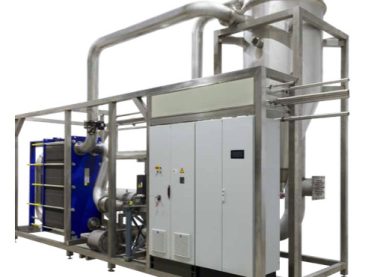 ENVIDEST MVR FC TFVacuum evaporators by mechanical vapour recompression and forced circulation
ENVIDEST MVR FC TFVacuum evaporators by mechanical vapour recompression and forced circulation ENVIDEST MFE 1Single effect thermal vacuum evaporators by forced circulation
ENVIDEST MFE 1Single effect thermal vacuum evaporators by forced circulation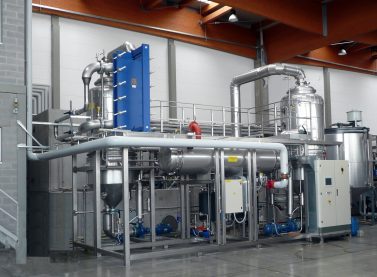 ENVIDEST MFE 2Double effect thermal vacuum evaporators by forced circulation
ENVIDEST MFE 2Double effect thermal vacuum evaporators by forced circulation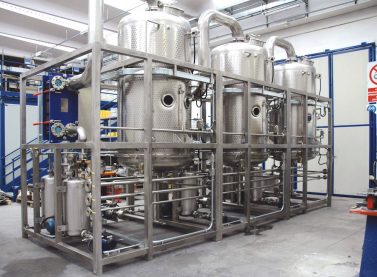 ENVIDEST MFE 3Triple effect thermal vacuum evaporators by forced circulation
ENVIDEST MFE 3Triple effect thermal vacuum evaporators by forced circulation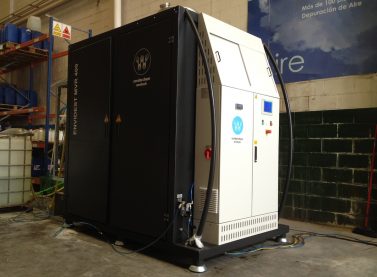 ENVIDEST MVR FFFalling film vacuum evaporators by mechanical vapour recompression and forced circulation
ENVIDEST MVR FFFalling film vacuum evaporators by mechanical vapour recompression and forced circulation ENVIDEST DPM 1Single effect thermal vacuum evaporators
ENVIDEST DPM 1Single effect thermal vacuum evaporators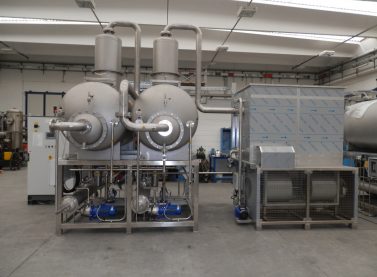 ENVIDEST DPM 2Double effect thermal vacuum evaporators
ENVIDEST DPM 2Double effect thermal vacuum evaporators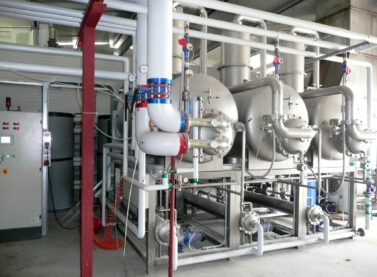 ENVIDEST DPM 3Third effect thermal vacuum evaporators
ENVIDEST DPM 3Third effect thermal vacuum evaporators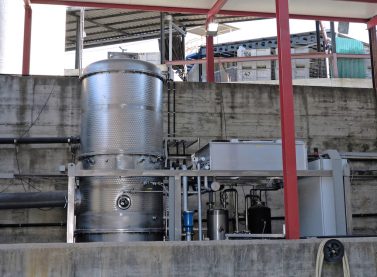 ENVIDEST LT VSHeat pump vacuum evaporators
ENVIDEST LT VSHeat pump vacuum evaporators ENVIDEST EAAtmospheric evaporators
ENVIDEST EAAtmospheric evaporators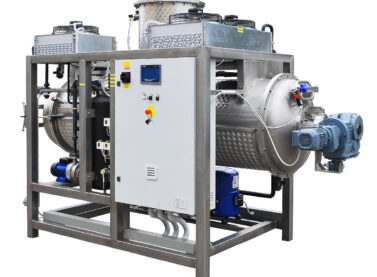 DESALT LT DRYHeat pump vacuum crystallizers
DESALT LT DRYHeat pump vacuum crystallizers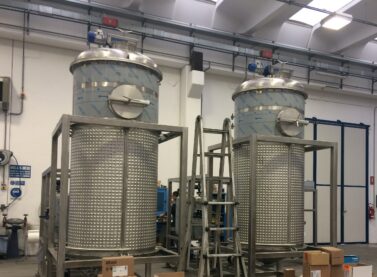 DESALT LT VRHeat pump vacuum crystallizers
DESALT LT VRHeat pump vacuum crystallizers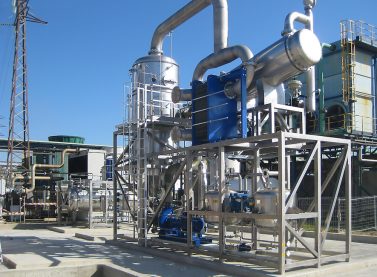 DESALT MFEThermal vacuum crystallizers by forced circulation
DESALT MFEThermal vacuum crystallizers by forced circulation DESALT VRThermal vacuum crystallizers
DESALT VRThermal vacuum crystallizers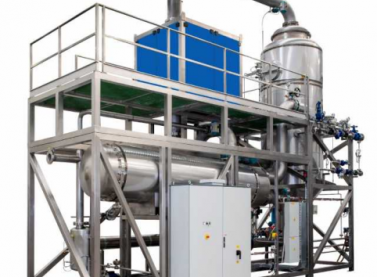 DESALT MVR FCVacuum crystallizers by mechanical vapour recompression and forced circulation
DESALT MVR FCVacuum crystallizers by mechanical vapour recompression and forced circulation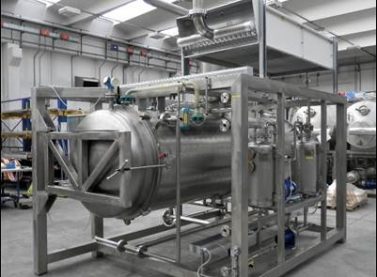 DESALT DRYThermal vacuum crystallizers
DESALT DRYThermal vacuum crystallizersAdvantages of evaporators in wastewater treatment
- Minimization of the waste volume to be managed
- Significant reduction in waste management costs
- Promoting the re-use of a significant part of the liquid effluents
- Possibility of implementation of a zero discharge system
- Fulfillment of the current regulations on discharge of effluents
- Reduction of the need to store large volumes of waste
- Reduction in greenhouse gas emissions when transporting the waste
- Reduction in the consumption of mains water by re-using treated water
- Absence of reagents (except for antifoam in some cases)
Industrial applications of wastewater evaporators
- Oily emulsions, coolant fluids, mould release agents
- Purging of compressors, water from washing floors
- Water from washing tanks and reactors (in the chemical, pharmaceutical, cosmetic and perfumery industries)
- Working and wash baths in galvanic processes and surface treatments
- Penetrating liquids
- Graphic arts waste (e.g. cleaning water and paint)
- Water treatment plant reject (e.g. reverse osmosis and demineralizers)
- Leachate from municipal solid waste dumps
- Digestate from biogas generation plants
- Food and beverage industry
- Pickling industry
- Energy generation
- Paper, minerals and extraction industries
The key role of wastewater evaporators in Zero Liquid Discharge (ZLD) systems
Technologies such as membrane filtration, vacuum evaporators, and crystallizers are key in wastewater reuse systems, making it more efficient and accessible for a wide range of industries.
Evaporation and crystallization stand out as the most effective methods for extracting clean water from industrial effluents and minimizing waste generation to near zero. These systems enable the concentration of waste streams while recovering high-quality water suitable for reuse.
Wastewater evaporatros for waste reduction and water recovery
In an evaporator, wastewater is gently heated under vacuum conditions, allowing water to evaporate at low temperatures. This process separates water from contaminants, which remain as a concentrated sludge. The vapor is then condensed back into clean, reusable water.
Even at this stage, the remaining sludge represents a significantly reduced volume compared to the original wastewater, lowering disposal costs and complexity. However, the process can be taken a step further with crystallization.
Crystallizers for complete separation of solids
Crystallization is applied after evaporation to remove dissolved solids—such as salts and minerals—by inducing them to form solid crystals. These can then be separated and collected, in some cases as valuable raw materials or by-products.
By converting dissolved contaminants into a dry, solid form, crystallization not only facilitates easier and safer disposal but also closes the loop in resource recovery, contributing to more sustainable industrial operations.
Types of Vacuum Evaporators
The following can be found for the effluent heating system:
Heat pump
Operation of this industrial evaporator is based on the refrigeration cycle of gas contained in a closed loop. The refrigeration gas is compressed by a compressor, as a result of which its temperature and pressure increase. It then circulates through the heat exchanger of the evaporator itself, heating the feed. As the system operates under vacuum, the boiling temperature is around 40 ºC.
The refrigeration liquid leaves the evaporator’s exchanger and is decompressed and cooled using an expansion valve. Passage through a second heat exchanger (the condenser) causes the vapor formed in the evaporator to condense and its temperature to increase immediately prior to passing through the compressor again, thus repeating the cycle.
The same refrigeration fluid allows the feed to be evaporated and the vapor generated to be condensed, therefore the system does not require any other heating or refrigeration source. This means that the process is highly advantageous from an economic and management viewpoint.
Mechanical vapor recompression
Operation of this industrial evaporator is based on the refrigeration cycle of gas contained in a closed loop. The refrigeration gas is compressed by a compressor, as a result of which its temperature and pressure increase. It then circulates through the heat exchanger of the evaporator itself, heating the feed. As the system operates under vacuum, the boiling temperature is around 40 ºC.
The refrigeration liquid leaves the evaporator’s exchanger and is decompressed and cooled using an expansion valve. Passage through a second heat exchanger (the condenser) causes the vapor formed in the evaporator to condense and its temperature to increase immediately prior to passing through the compressor again, thus repeating the cycle.
The same refrigeration fluid allows the feed to be evaporated and the vapor generated to be condensed, therefore the system does not require any other heating or refrigeration source. This means that the process is highly advantageous from an economic and management viewpoint.
Multiple-effect
This technology comprises a series of mutually connected evaporators in which the vacuum steadily increases from first to last. This means that, in principle, the boiling temperature decreases, thus allowing the vapor generated in an evaporator (or effect) to be used as heating fluid in the following effect.
Its main advantage with respect to a single evaporator is the saving in both heating fluid and refrigeration fluid. This is one of the economically most competitive options for treating high flows.
Operation and applications of wastewater evaporators
Vacuum evaporation is a simple process of high energy efficiency, i.e. low energy consumption and it is practically maintenance free. Normally, evaporation is preceded by other concentration technologies, such as reverse osmosis, for treating large volumes of waste water.
Evaporation in vacuum: The basic operation is very simple and is based on bringing the effluent to its boiling point, which is around 40°C when working under vacuum conditions. When the effluent begins to boil in the evaporator boiler tank, the steam condenses and is withdrawn from the system as more effluent is fed into the boiler tank. The effluent must be preheated before being fed for the evaporation process to continue. The technology used to pre-heat the effluent before reaching the tank constitutes the main difference between the different types of vacuum evaporator.
Treated water (distilled) that has been extracted from the liquid waste is of high quality and can be recycled in the plant for various applications (e.g. production and refrigeration); thus reducing the consumption of drinking water.
The application of industrial evaporation technologies for treating industrial liquid waste where it is produced has a series of advantages. Firstly, the waste can be minimized by concentration, thus significantly reducing its management cost. In some cases, it is possible to evaluate the concentrate itself for possible re-use in the same process or in alternative applications. Minimization at the point of origin also reduces the need for storage of large volumes of hazardous waste in industrial sites, and reduces the risk of spills caused by accidents during the transport of liquid waste. Finally, it contributes to a reduction in greenhouse gas emissions produced when transporting the waste.
Vacuum concentration
Vacuum evaporators are characterized by concentrating with low power consumption, dissolved liquid or solid products. The concentrated product can become the final product of the production process or a by-product to be reused or recycled.
This procedure, under vacuum conditions, achieves a double goal. On the one hand, the product is not subjected to high temperatures, a critical fact when it comes to thermolabile substances (vitamins, proteins, hormones, etc). On the other hand, while the pressure decreases, the water boiling temperature is also reduced. This event enables water evaporation without consuming excess power.
Vacuum evaporators are suitable to concentrate a product without subjecting it to high temperatures, either because it denatures, deactivates or loses most properties. This is the case for most products in biotechnological industries (enzymes, vitamins, hormones, etc), food industries (concentrated juices, sweeteners like sugar and stevia, etc.) and pharmaceutical and chemical industries.
Condorchem Envitech offers “turnkey” solutions in vacuum concentration projects. We design, build and install vacuum concentration plants and have a wide range of concentrators to provide the most efficient solution in each particular case.